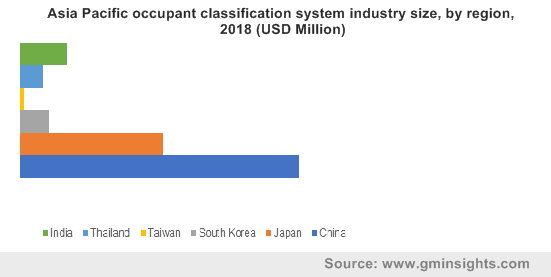Home > Automotive > Automotive Technology > Automotive Sensors > Occupant Classification System Market
Occupant Classification System Market Analysis
- Report ID: GMI3254
- Published Date: Apr 2019
- Report Format: PDF
Occupant Classification System Market Analysis
The bladder system is widely used in the occupant classification system market. These basically comprise fluid containing bladder placed in the seat, which is used to detect the weight of the occupant. The PODS technology provided by Delphi consists of a weight-sensing bladder system, which is mounted under the cushion of passenger seats. It uses signal processing & sophisticated algorithms. This enables airbags to variably suppress or deploy the pressure. This Delphi system consists of a pressure sensor under the cushion, electronic control unit, and Silicon fluid-filled bladder system. The sensor signals the weight of the occupant to the control unit. The bladder sensors have been adopted in many mid-range cars, which have influenced the market.
Other technologies used in the market include strain gauge and pressure-sensitive tape system. Strain gauge systems by companies, such as Gagetek Co. and BF Goodrich, use silicon micromachined technology. These systems use torsional-sensing load cells, which can detect the position & weight of the occupant for the airbag deployment. The pressure-sensitive tape systems are generally implemented in luxury cars and are expected to be implemented growingly in the market with the growing demand for luxury cars.
The occupant classification system market is expected to have a high growth potential in economy-class vehicles. The growth in the middle-class population and disposable income has made economy vehicles more popular in regions, such as Asia, Middle East while manufacturers are providing these systems in economy cars.
Luxury cars contribute to a large share as luxury car manufacturers have always been inclined towards the adoption of sophisticated and improved safety systems in cars. Moreover, the buyers of luxury cars consistently demand for high-level vehicle safety systems. This has influenced the market growth in the luxury car segment. Automotive players, such as Mercedes-Benz, BMW, and Audi, have already implemented these systems in their several passenger car models.
Majorly used components in the occupant classification system market are ECUs and sensors. The ECU helps to transfer the signals from sensors to airbag systems for deciding the required force. The ECU is crucial for controlling the airbags and other electronic systems in the car. The sensors are used for detecting weight, size, and the seating positions of occupants. In advanced safety systems, the sensors are being used to detect other datasets such as if the passenger is wearing a seat belt or not and for determining when the child seat is fitted using seat tension sensors. Strain sensors, pressure sensors, and bladder type sensors are widely used technology.
Asia Pacific is expected to be one of the dominating regions for occupant classification system market growth. Mahindra KUV 100, Toyota Etios, Maruti Suzuki Desire are some of the popular economic cars in the region, which have implemented airbags for safety. Moreover, several automotive manufacturers have focused on the Asia Pacific region for the expansion in manufacturing activities, leading to increased vehicle production. Around 23 million cars were manufactured in China in 2018. The Asia Pacific region has several automakers and component manufacturers present including Robert Bosch, ZF TRW, Continental, Hyundai Wia, and others.
Europe is expected to be another important region for market growth. European countries have people with high income and have a high demand for safety features. The presence of several luxury car manufacturers has influenced automotive growth in the region. Moreover, it has influenced the research & development to embed cars with enhanced safety features.

